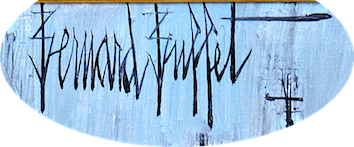

(Paris, 1928 - Tour, 1999)

From 1942 Bernard Buffet followed a drawing evening class in Paris. He joins the Beaux-Arts Academy in 1944 and stayed for two years in the studio of Eugène Narbonne. The paintings he realizes during this period, called " miserabilist ", such as l'Enterrement (1941), Pieta (1946) , Deux hommes nus (1947) , and other ascetic paintingsof the 1940s, show the will of a young painter to singling out the abstract movement.
In 1946 he exhibited for the first time at the Salon des moins de Trente Ans ans. The same year, he painted a Crucifixion in which the characteristics of his style are already present. The next year, in 1947, he exhibited at the Salon des Artistes Independents and in December held its first solo exhibition presented by Pierre Descargues in the Librairie des impression d'art, organized by Guy Weelen and Michel Brient. The State, through Raymond Cogniat, made its first purchase for the Musée National d'Art Moderne in Paris: the painting Nature morte au poulet.
In April 1948, he presented Le Buveur, as a candidate for the Prix de la Jeune Peinture organized at the Drouant-David Gallery, 52 rue du Faubourg Saint-Honoré in Paris. He does not get the prize, but is noticed by the Dr Maurice Girardin, a contemporary art collector who acquires seventeen works buffet between 1948 and 1953 and draws the attention of Emmanuel David on the young Bernard Buffet. A few days later, Emmanuel David visits the apartment of 29 rue des Batignolles and offers Bernard Buffet entering his gallery with an exclusive contract. This contract has subsequently been shared with Maurice Garnier. In June 1948, aged 19, he won the Prix de la Critique placed equal firts with Bernard Lorjou, twenty years older than him.
In 1949 Pierre Descargues publishes Bernard Buffet and a personal exhibition is dedicated to him in Paris at the Drouant-David Gallery. That same year, Bernard Buffet get married with Agnes Nanquette, a comrade of Fine Arts, he divorced the following year. An art lover offers him to rent a workshop in Garches. As rent, Bernard Buffet gives him one painting by month.
In 1955, a referendum organized by the magazine Connaissance des Arts refers Bernard Buffet as the best postwar painter. The same year 1955, he painted the models of sets and costumes for La Chambre of Georges Simenon who becomes his friend.
In 1958 , the first retrospective of his work is held at the Galerie Charpentier in Paris. That same year, Pierre Bergé published Bernard Buffet. Apart from his participations in international exhibitions, he exhibited during solo shows all around the world: London, New York, Chicago, Montreal, Rome, Amsterdam, Brussels, Geneva, Berlin, Tokyo, Madrid and Russia.
Subordinating the subjects to his technique, Bernard Buffet applies his style to various themes : the Circus, War, still lifes, birds, portraits and self portraits, landscapes, etc. Regardless of his characteristic signature, he uses recognizable graphics and grey colours, violently scratched by black lines. His manner, very typical, assure his success among a very large public. Some series, such as The Circus, The Birds, The Corida, Sumi and Kabuki, have shown a stylistic renewal through the introduction of colourwithout certain that this new provision has supplanted the gray agreements style of ineffable his first series .
Bernard Buffet also illustrated many books such as Les Chants de Maldoror by the Count of Lautréamont (1952), Recherche de la Pureté by Jean Giono (1953), La Passion du Christ (1954), La Voix Humaine by Jean Cocteau (1957), Les Voyages Fantastiques by Cyrano de Bergerac (1958), Saint-Cast, poem of Baudelaire (1962), Toxique, by Françoise Sagan (1964), Jeux de Dames, poems by Verlaine, Rimbaud and Baudelaire (1970), L'Enfer by Dante (1976) or La Révolution Française (1977).
In May 1958, the painter Xavier Zevaco presented him to Annabel Schwob in Saint-Tropez. It was love at first sight. Bernard then left Pierre Bergé, with whom he had lived for several years and who ran his career. The December 12, 1958, he married Annabel Schwob at Ramatuelle. Buffet portraid his wife tirelessly. In 1961, one of his exhibitions was titled Thirty times Annabelle Schwob.
In 1961 he painted a series of paintings depicting the life of Christ to decorate the chapel of Château l'Arc. Ten years later, at the request of Archbishop Pasquale Macchi, secretary of Pope Paul VI, Bernard Buffet will offer these paintings to the Vatican Museum where they are exposed in a particular room.
Since 1947, year of his first exhibition, he presents a solo exhibition every year in Paris, and since 1952, every year, he painted a new series. His exceptional fertility fueled the art market and earned himself the title of most famous artist of his generation. He was made a Knight of the Legion of Honor in 1971 and elected to the Academy of Fine Arts in 1974. His style, immediately recognizable, also earned him an international reputation. He is notably the only French artist to have seen dedicate a museum in Japan during his lifetime, in 1973. In 1978, at the request of the postal administration, Bernard Buffet performs a model for a three-franc stamp The Institute and the Pont des arts. On this occasion the postal museum in Paris presents a retrospective exhibition of his works.
In 1999, Bernard Buffet, whose quality of life is decreased by Parkinson's disease for several years, committed suicide by asphyxiation in his studio from Domaine de la Baume, near Tourtour (Var), leaving behind him a rich collection of more than 2,000 works.
Bernard Buffet is the most famous painter of his generation.